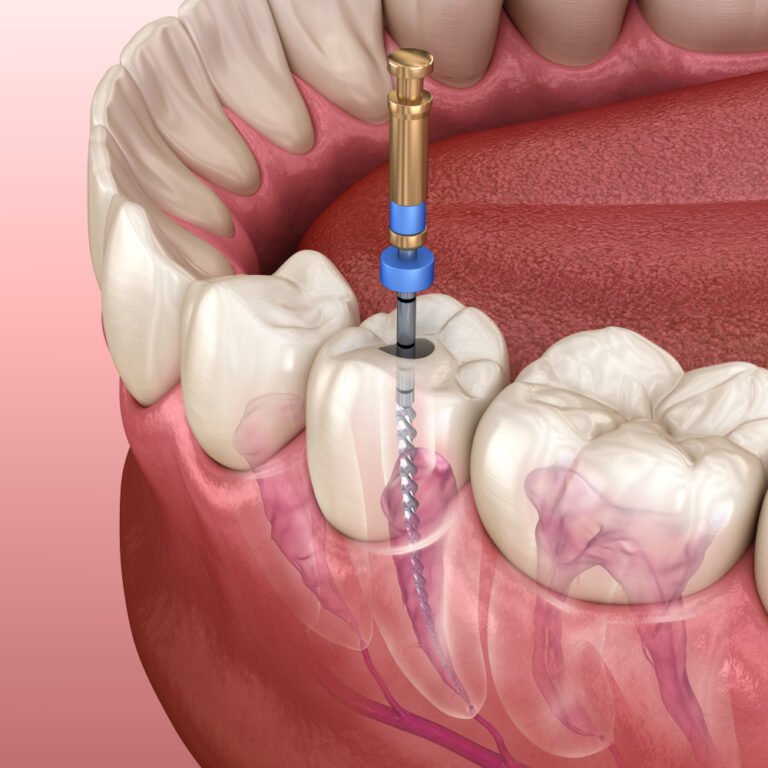Dental Root Canal
A dental root canal, also known as endodontic therapy, is a procedure to treat a tooth that has a damaged or infected pulp (the innermost part of the tooth). The pulp contains nerves, blood vessels, and connective tissue, and when it becomes infected or inflamed, it can cause severe pain and other dental issues.

Talk to your dentist Now
What is Root canal/RCT?
A root canal, or root canal treatment (RCT), is a dental procedure used to treat a tooth that has a damaged or infected pulp (the soft inner part of the tooth). The pulp contains nerves, blood vessels, and connective tissue, and if it becomes infected or injured, it can cause severe pain and swelling.
During a root canal procedure, the dentist or endodontist (a specialist in the treatment of dental pulp) removes the damaged or infected pulp, cleans and disinfects the inside of the tooth, and then fills and seals the space with a material called gutta-percha. This helps to prevent further infection and preserves the structure of the tooth. In some cases, a dental crown may be placed on the treated tooth to provide additional support and protection.
Root canal treatment is often necessary when there is deep decay, a cracked or fractured tooth, repeated dental procedures on a tooth, or a trauma to the tooth. The procedure is performed to save the natural tooth and alleviate pain and discomfort associated with pulp inflammation or infection. If left untreated, a dental abscess may form, and the infection can spread to other areas of the face and head.
While the idea of a root canal may be associated with pain, modern techniques and anesthesia make the procedure relatively comfortable for patients. It is an effective way to save a tooth and restore oral health. If you suspect you may need a root canal, it’s essential to consult with a dentist or endodontist for an accurate diagnosis and appropriate treatment.


Quickdiagno Dental Root canal processure
Quickdiagno dental root canal treatment procedure involves several steps:
Initial Assessment:
- The dentist will perform a thorough examination, including X-rays, to assess the extent of damage or infection in the tooth’s pulp.
Local Anesthesia:
- Before starting the root canal procedure, the dentist will administer local anesthesia to numb the affected tooth and the surrounding area. This ensures that the patient is comfortable and does not experience pain during the treatment.
Isolation:
- The dentist will place a rubber dam around the tooth to keep it dry and free from saliva during the procedure. This isolation helps maintain a sterile environment.
Access Opening:
- A small opening is made in the crown of the tooth to access the pulp chamber and root canals. This is usually done using dental drills.
Pulp Removal:
- The damaged or infected pulp is carefully removed from the pulp chamber and the root canals. Special instruments are used to clean and shape the canals to prepare them for filling.
Cleaning and Disinfection:
- The dentist uses irrigation solutions to clean and disinfect the root canals thoroughly. This helps eliminate bacteria and debris from the canals.
Filling the Canals:
- Once cleaned, the root canals are filled with a biocompatible material called gutta-percha. This material seals the canals to prevent further infection and provides structural support to the tooth.
Sealing the Access Opening:
- The access opening in the tooth is sealed with a temporary or permanent filling. In some cases, a dental crown may be recommended for additional protection and strength.
Follow-up Appointments:
- In some cases, the dentist may schedule a follow-up appointment to monitor the healing process and ensure the tooth is functioning properly. If a dental crown is required, a separate appointment is typically scheduled for crown placement.
Restoration (Optional):
- In cases where a dental crown is not placed immediately after the root canal, a separate appointment is scheduled for the placement of a permanent crown to protect and restore the tooth’s functionality.
It’s important to note that the specific details of the root canal procedure can vary based on the individual case and the dentist’s preferred techniques. Patients should follow post-treatment care instructions provided by their dentist to promote healing and maintain oral health.
